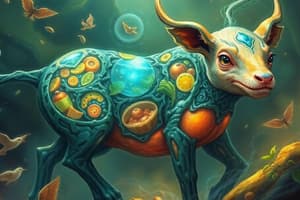Podcast
Questions and Answers
What is the function of pseudopodia in Amoeba?
What is the function of pseudopodia in Amoeba?
- To release enzymes
- To absorb digested products
- To egest undigested waste
- To move around prey and enclose it in a food vacuole (correct)
Heterotrophic organisms make complex organic molecules from simple inorganic ones.
Heterotrophic organisms make complex organic molecules from simple inorganic ones.
False (B)
What type of digestion involves the secretion of enzymes onto food, followed by absorption of the digested products?
What type of digestion involves the secretion of enzymes onto food, followed by absorption of the digested products?
saprophytic
In the human gut wall, the layer of cells in direct contact with food is called the __________.
In the human gut wall, the layer of cells in direct contact with food is called the __________.
Which of the following best describes the function of the enzyme amylase?
Which of the following best describes the function of the enzyme amylase?
Bile is produced in the gall bladder.
Bile is produced in the gall bladder.
What is the role of villi in the small intestine?
What is the role of villi in the small intestine?
The waves of contraction that force food along the gut are called __________.
The waves of contraction that force food along the gut are called __________.
What is the main function of carnassial teeth in carnivores?
What is the main function of carnassial teeth in carnivores?
Ectoparasites live inside the host organism.
Ectoparasites live inside the host organism.
Flashcards
Unicellular organism nutrition
Unicellular organism nutrition
Move around prey and enclose it in a food vacuole, enzymes released from lysosomes digest prey, products absorbed, waste egested.
Autotrophic Nutrition
Autotrophic Nutrition
Makes complex organic molecules from simple inorganic ones, like Photoautotrophic (uses light) and Chemoautotrophic (oxidizes molecules).
Heterotrophic Nutrition
Heterotrophic Nutrition
Consume complex organic food molecules, like Saprophytic (external digestion) and Holozoic (internal digestion).
Endopeptidases
Endopeptidases
Signup and view all the flashcards
Exopeptidases
Exopeptidases
Signup and view all the flashcards
Buccal cavity function
Buccal cavity function
Signup and view all the flashcards
Liver Function
Liver Function
Signup and view all the flashcards
Gall bladder role
Gall bladder role
Signup and view all the flashcards
Duodenum function
Duodenum function
Signup and view all the flashcards
Ileum Function
Ileum Function
Signup and view all the flashcards
Study Notes
- Amoeba use pseudopodia to engulf prey into a food vacuole
- Enzymes from lysosomes digest the prey within the food vacuole
- Digestion products are absorbed into the cytoplasm
- Undigested waste is eliminated through exocytosis
Types of Nutrition
- Autotrophs create complex organic molecules from simple inorganic ones.
- Heterotrophs consume complex organic food molecules
- Photoautotrophs use light for food synthesis
- Chemoautotrophs oxidize inorganic molecules for energy to synthesize food
- Saprophytes digest food externally by secreting enzymes. They then absorb the digestion products
- Holozoic nutrition involves internal digestion through ingestion, absorption, assimilation, and egestion
Proteases
- Endopeptidases break peptide bonds within a polypeptide chain, creating shorter chains
- Exopeptidases break peptide bonds at the ends of peptides
Digestive Systems in Different Organisms
- Hydra is a simple organism with a sac-like gut and a single opening
- Earthworms have a tube gut with separate openings and specialized regions
- Humans also have a tube gut with specialized regions for digestion
Gut Wall Layers
- Serosa: tough, outer connective tissue layer
- Muscle: longitudinal and circular muscle layers for peristalsis
- Submucosa: contains blood and lymph vessels for nutrient absorption
- Mucosa: secretes mucus and digestive juices, and absorbs products
- Epithelium: layer of cells in contact with food
Digestion in the Human Digestive System
- Mechanical digestion occurs in the buccal cavity. The tongue moves food, and saliva moistens food and maintains pH for amylase
- Amylase digests starch and glycogen into maltose, forming a bolus that is then swallowed
- The oesophagus uses peristaltic waves to move the bolus to the stomach while mucus lubricates the passageway
- Gastric glands in the stomach's mucosa produce gastric juice
- Oxyntic cells produce hydrochloric acid (HCl), which kills bacteria and lowers the pH to 2
- Chief cells secrete pepsinogen, which is activated into pepsin by HCl
- Goblet cells secrete mucus to protect the stomach lining
- The liver produces bile to emulsify lipids and neutralize stomach acid to create a slightly alkaline pH in the duodenum for pancreatic enzymes
- The gall bladder stores bile and delivers it to the duodenum via the bile duct
- Digestion continues on the epithelial cells of the villi in the duodenum. Namely, sucrose becomes glucose and fructose via sucrase, maltose becomes alpha glucose via maltase, and lactose becomes glucose and galactose via lactase
- Polypeptides undergo continued digestion by endopeptidases and exopeptidases
- Amino acids are actively transported into the epithelial cells of the villi and then move to the capillaries through facilitated diffusion in the ileum
- Glucose and other monosaccharides enter epithelial cells via co-transport with sodium ions before facilitated diffusion to capillaries in the ileum
- Fatty acids and glycerol diffuse into epithelial cells, are reassembled into triglycerides, and are transported by the lacteal to the lymphatic system
- The villi in the small intestine increase the surface area for absorption of digested food
Pancreas
- The pancreas produces enzymes transported to the duodenum
- Pancreatic amylase digests carbohydrates
- Trypsinogen is activated into trypsin in the duodenum via the enzyme enterokinase
- Pancreatic lipase enzymes digest triglycerides into monoglycerides and eventually glycerol and fatty acids
Features of Carnivore Adaptations
- They have pointed canines to pierce flesh and kill prey
- Incisors grip and tear flesh
- Sharp-cusped premolars and molars cut and crush
- Carnassial teeth act as shears
- Strong jaw muscles vertically clamp down on prey
Features of Herbivore Adaptations
- Premolars and molars are cheek teeth that fit together in a W/M shape and jaw horizontal plane
- Teeth have open, unrestricted roots for continuous growth
- Incisors are used on the lower jaw to cut vegetation against the upper jaw in place of canines
- There is loose articulation of the jaw
- Diastema is the space where the tongue can push food to the grinding cheek teeth
Gut Adaptations
- Carnivores have relatively short guts, a large stomach, and a small caecum
- Non-ruminant herbivores have very long guts and a large caecum
- Ruminants have special digestive adaptations
Parasites
- Parasites live on or in a host organism and harm it
- Ectoparasites live on the surface of other organisms (e.g., head louse)
- Endoparasites live inside another organism (e.g., pork tapeworm)
Head Louse Adaptations for Nutrition
- Claws help them hold onto hair
- They lay eggs that are glued to the based of hairs
- They feed by sucking blood from the scalp of the host
Pork Tapeworm
- Thick cuticle produces anti-enzymes
- Scolex allows them to attach to the gut wall
- They have a reduced gut to feed by absorbing pre-digested nutrients through the cuticle
- They produce a large number of eggs that pass out in the faeces to infect secondary hosts
Ruminant Digestion
- Grass gets mixed with saliva to form cud and then it is chewed before being swallowed
- The cud enters the rumen, where cellulose-digesting bacteria break down cellulose into glucose to produce fermented organic acids that are absorbed into the bloodstream
- The fermented cud from the rumen enters the reticulum, where it gets regurgitated for re-chewing.
- Re-chewed cud is swallowed and enters the omasum for water absorption
- From the omasum, food enters the abomasum, where protein digestion occurs
- Products of digestion are absorbed into the blood in the small intestine
Studying That Suits You
Use AI to generate personalized quizzes and flashcards to suit your learning preferences.




